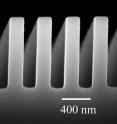Physicists tweak quantum force, reducing barrier to tiny devices
Cymbals don't clash of their own accord – in our world, anyway. But the quantum world is bizarrely different. Two metal plates, placed almost infinitesimally close together, spontaneously attract each other.
What seems like magic is known as the Casimir force, and it has been well-documented in experiments. The cause goes to the heart of quantum physics: Seemingly empty space is not actually empty but contains virtual particles associated with fluctuating electromagnetic fields. These particles push the plates from both the inside and the outside. However, only virtual particles of shorter wavelengths — in the quantum world, particles exist simultaneously as waves — can fit into the space between the plates, so that the outward pressure is slightly smaller than the inward pressure. The result is the plates are forced together.
Now, University of Florida physicists have found they can reduce the Casimir force by altering the surface of the plates. The discovery could prove useful as tiny "microelectromechanical" systems — so-called MEMS devices that are already used in a wide array of consumer products — become so small they are affected by quantum forces.
"We are not talking about an immediate application," says Ho Bun Chan, an assistant professor of physics and the first author of a paper on the findings that appears today in the online edition of the journal Physical Review Letters.
"We are talking about, if the devices continue to be smaller and smaller, as the trend of miniaturization occurs, then the quantum effects could come into play."
More specifically, the finding could one day help reduce what MEMS engineers call "stiction" — when two very small, very close objects tend to stick together.
Although stiction has many causes — including, for example, the presence of water molecules that tend to clump together — the Casimir force can contribute. Such quantum effects could prove important as the separations between components in tiny machinery shrink from micrometer, or millionths of a meter, toward nanometer size, Chan said.
"A lot of people are thinking of ways to reduce stiction, and this research opens up one possibility," he said.
Dutch physicist Hendrik Casimir first predicted that two closely spaced metal plates would be mutually attracted in 1948. It took several decades, but in 1996, physicist Steve Lamoreaux, then at the University of Washington, performed the first accurate measurement of the Casimir force using a torsional pendulum, an instrument for measuring very weak forces.
Subsequently, in a paper published in Science in 2001, Chan and other members of a Bell Labs team reported tapping the Casimir force to move a tiny metal see-saw. The researchers suspended a metal sphere an extremely tiny but well-controlled distance above the see-saw to "push" it up and down. It was the first demonstration of the Casimir force affecting a micromechanical device.
In the latest research, the physicists radically altered the shape of the metal plates, corrugating them into evenly spaced trenches so that they resembled a kind of three-dimensional comb. They then compared the Casimir forces generated by these corrugated objects with those generated by standard plates, all also against a metal sphere.
The result? "The force is smaller for the corrugated object but not as small as we anticipated," Chan said, adding that if corrugating the metal reduced its total area by half, the Casimir force was reduced by only 30 to 40 percent.
Chan said the experiment shows that it is not possible to simply add the force on the constituent solid parts of the plate — in this case, the tines — to arrive at the total force. Rather, he said, "the force actually depends on the geometry of the object."
"Until now, no significant or nontrivial corrections to the Casimir force due to boundary conditions have been observed experimentally," wrote Lamoreaux, now at Yale University, in a commentary accompanying publication of the paper.
Source: University of Florida
Other sources
- Physicists Tweak Quantum Force, Reducing Barrier To Tiny Devicesfrom Science DailyTue, 15 Jul 2008, 1:21:07 UTC
- Physicists tweak quantum force, reducing barrier to tiny devicesfrom PhysorgMon, 14 Jul 2008, 16:49:06 UTC
- Physicists tweak quantum forcefrom Science BlogMon, 14 Jul 2008, 16:21:07 UTC
